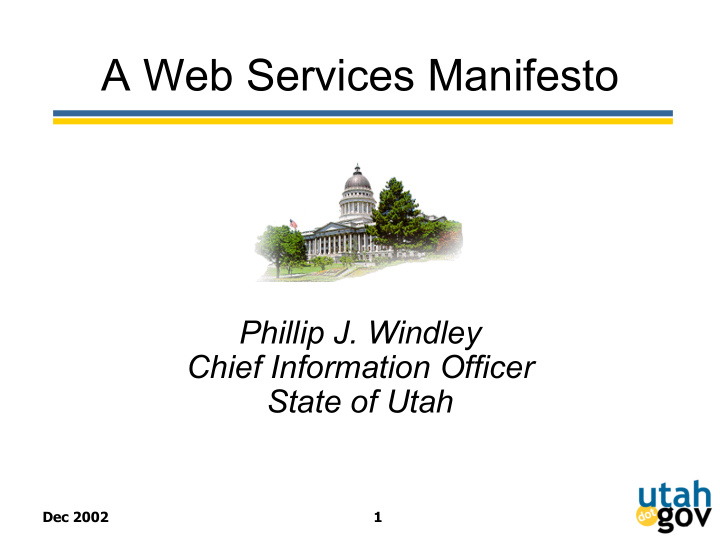



A Web Services Manifesto Phillip J. Windley Chief Information Officer State of Utah Dec 2002 1
The Williams Family Life Event: Moving to Utah • Change of address • Register car • Register to vote • Enroll child in school • Bussing • City services • Health information • Child safety • Check the commute • Tax information Dec 2002 2
Federating Services Moving to Utah Child entering School • Real estate • Health information • Taxes • Grades • Register car • Tuition and fees • Register to vote • Books • Enroll child in school • Child safety • Bussing • Bussing • City services • Federal programs • Utilities • Check commute • Health information • Banking • Child safety Shared services • Change of address Private services • Check commute Dec 2002 3
Web Services • Web services are self-contained pieces of code with three distinguishing properties: 1.Communicate in an interoperable XML protocol, such as SOAP. 2.Describe themselves in an interoperable XML meta-format, such as WSDL. 3.Federate globally through XML based registry services, such as UDDI. • Not defined in terms of SOAP, WSDL, and UDDI. Dec 2002 4
Legacy Data • Governments and other organizations control vast data resources • That data is held hostage in disconnected, legacy data resources • eGovernment is about, in part, freeing data from siloed systems and legacy platforms Dec 2002 5
Enabling Web Services • There are things we can do, for almost nothing, as we put services online that will have a huge impact on future development. • But…we have to design wisely. Dec 2002 6
Design Principles 1. Every data element and collection is a resource 2. Every resource should have a URI 3. Cool URI’s don’t change 4. Preserve the structure of data until the last possible moment ( i.e. return XML) 5. Make XML Schemas available online for your XML 6. Data queries on existing resources should be done with a GET 7. Use POST to create new resources Dec 2002 7
Design Principles (cont) 8. Document your service API using WSDL, WRDL, or some other standard 9. Advertise the presence of the data using WSIL 10. Adhere to data standards such as RSS where available 11. Use Metadata (RDF) for XML 12. Use HTTP authentication as much as possible 13. Make data available in multiple flavors Dec 2002 8
For More Information • phil@windley.org • http://www.windley.com • http://xml.amazon.com • http://www.soaplite.com • http://xml.apache.org/axis Dec 2002 9
Recommend
More recommend